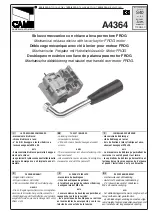
- 14 -
Lithium-ion batteries have nearly no self-discharge and
do not have a memory effect. If properly used, they
will reliably supply your tool with power for several
years (approx. 700 - 1000 charge cycles).
In general, avoid deep discharging or overcharging
the lithium-ion battery under any circumstances. It will
be permanently damaged from this.
3.6.0. CLEANING AND DISPOSING OF THE TOOL
Use and dispose of used materials and substances properly, in
particular cleaning agents and solvents.
Do not throw the used battery in the household trash, a fire, or in water.
Have it properly disposed of by a specialist shop or the manufacturer.
3.7.0. RISK OF INJURY AND DAMAGE TO THE TOOL
1. Make sure that none of the tool parts are
damaged. All damaged parts must be repaired
prior to using the device. If you work with
damaged tool parts, you risk injury.
2. If you work on raised platforms, wear a safety belt and avoid
letting the tool fall down. Non-compliance may lead to injury
and significant damage.
3. First remove the battery before you clean the device or perform
general maintenance.
4. Never hold your face near the exhaust holes.
5. Avoid skin contact with substances such as lubricating grease
and oil. These substances are flammable on skin. If you do come
into contact with them, thoroughly wash the area.
6. Avoid unstable working positions. You might fall and injure
yourself.
7. Maintain your tool carefully. Follow the operating instructions for
maintenance and cleaning.
- Keep the handle free of lubrication greases and dirt.
8. Use the tool carefully and pay attention to proper use. Always
concentrate while working.















































